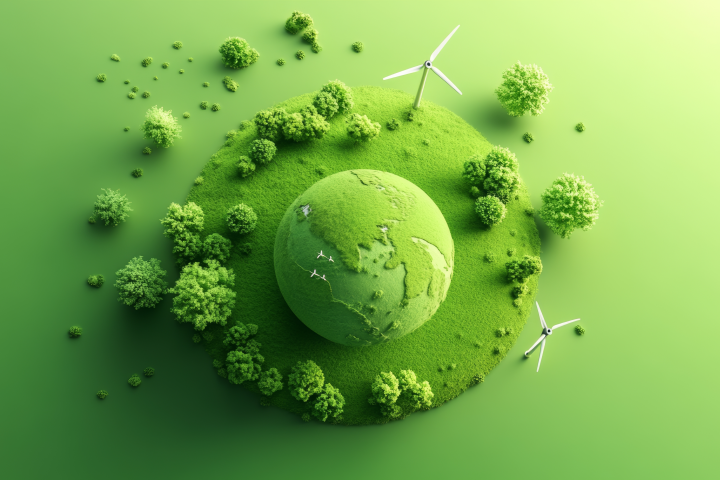What is the Green Energy Transition? Understanding the Shift Towards a Sustainable Future

The world is facing a climate change emergency, and our energy revolution lies at its heart. As climate change accelerates and environmental degradation intensifies, there is a compelling need to reimagine how we power our lives. For decades, global energy systems have been dominated by fossil fuels, including coal, oil and natural gas. Despite these energy sources powering development and industrial growth, they have also been the largest contributors to greenhouse gas emissions (GHGs), air pollution and environmental degradation. Hence, the need for a green energy transition. A global effort to replace energy systems based on fossil fuels with low-carbon, clean, and renewable alternatives. The green energy transition seeks to transform the production, distribution, and use of energy on a global scale, from household solar panels to enormous offshore wind farms.
What is Green Energy Transition and Why It Matters
Green energy refers to energy generated from renewable natural resources such as sunlight, wind, water, geothermal heat and biomass.[1] Unlike fossil fuels, these energy sources emit little to no GHGs, resulting in a smaller environmental carbon footprint.[2] The green energy transition is therefore a process of moving away from traditional fossil fuel-based energy systems to clean, renewable energy sources.[3] This process does not only focus on replacing coal plants with wind turbines and the likes, but it is a significant transformation of the energy sector that informs energy generation, infrastructure, investment, law, policy and consumption. The main driver of this transition is the global climate change commitments outlined in the Paris Agreement.
So, why does this transition matter? The first significance of the green energy transition is environmental preservation. Renewable energy sources significantly reduce carbon emissions, which in turn decreases the impacts of climate change. These sources also reduce air and water pollution, advancing the protection of ecosystems and preserving biodiversity. Secondly, the transition is projected to be a major driver of green economic growth through new industries and job creation. This includes, amongst others, sustainable finance specialists, solar technicians, eco-builders, recyclers and electric vehicle engineers. Third, according to the Clean Air Fund, clean air results in reduced incidence of respiratory illnesses and improved public health outcomes. Last, diversifying the energy sector and power generation sources render the countries such as South Africa less vulnerable to global supply disruptions. This energy diversification increases resilience and national security, especially in light of the recent instabilities in the geopolitical space. However, these significances in the green energy transition are met by key factors and challenges.
Key Factors and Challenges for Green Energy Transition
The key factors in the acceleration of renewable energy sources include technology advancement in solar panels, wind turbines and battery storage. This advancement has made renewable energy sources more affordable and accessible to consumers. Energy management technologies such as smart grids, electric vehicles, and Artificial Intelligence (AI)-powered energy play a significant role in improving energy efficiency.
Moreover, governments are playing a major role in this acceleration through various policy measures, including carbon pricing, clean energy incentives and phasing out fossil fuel subsidies. Countries such as Germany, Kenya and South Africa are notably pioneering the ambitious energy transition plans. This investment from governments has led to a surge in green finance. For instance, green bonds and Environmental and Social Governance (ESG) investments are channelling billions into clean energy projects. Furthermore, customers are pressuring businesses to engage in greener practices and requesting cleaner energy solutions such as rooftop solar systems. The growth in youth-led climate movements such as World’s Youth for Climate Justice (WYCJ) is also shaping climate change public awareness and policy developments.
However, this acceleration in the green energy transition presents inevitable challenges. For instance, solar and wind power heavily depend on weather conditions, which affect their performance and reliability. Despite the affordability of renewable sources, there are challenges in baseline investment in new systems and grids, especially in developing countries. Moreover, political resistance, particularly in countries where fossil fuels are economically dominant, may slow the transition process. Ultimately, the transition towards green energy must be equitable, fair and just. Communities and workers must be supported through retraining, compensation and new opportunities.
What’s Next?
Despite the benefits and challenges, looking ahead, the revolution of green energy transition will continue as it is no longer a distant ideal. It is a necessary transformation that is already progressing. Countries, industries, and people are embracing cleaner and sustainable energy sources. As such, we all have a part to play. Whether it be through science, laws, activism, professions, or day-to-day activities, the transition is empowered by people. It is more than just a shift; it's a redefinition of progress that requires alignment with people and the planet.
[1] White Paper on the Promotion of Renewable Energy and Clean Energy Development: Part One – Promotion of Renewable Energy, 1 August 2002.
[2] M Farghali, AI Osman, Z Chen et al. ‘Social, Environmental, and Economic Consequences of Integrating Renewable Energies in the Electricity Sector: A Review’ (2023) 21 Environmental Chemistry Letters.
[3] F Muhire, D Turyareeba, MS Adaramola et al. ‘Drivers of Green Energy Transition: A Review, Green Energy and Resources’ (2024) 2(2) Green Energy and Resources.
